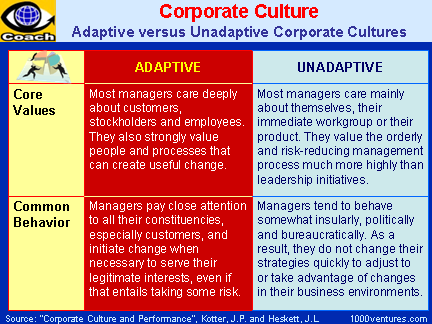|
Teachings from
Tao Te Chin by
Lao
Tzu |
|
Men are born soft and supple; dead, they
are stiff and hard.
Plants are born tender and pliant; dead,
they are brittle and dry.
Thus whoever is stiff and inflexible is a
disciple of death.
Whoever is soft and yielding is a disciple of life. |

|
Building in Adaptiveness at Three Level |
-
Strategies
-
Organizations
-
Operations
|
|
Creating a Questioning
Organization3 |
-
Instill a questioning attitude.
Ensure that everyone understands the
vision and
goals of the enterprise,
that
people are empowered to achieve, and that they know they have to
question every rule and assumption, every established way
of doing things if they are going to initiate creative changes that
the organization needs...
More
|
|
Why Adaptive Organization?
In
today's world
characterized by rapid unpredictable change and volatility, the sustainable
ability to change is much more important than the ability to create change
in the first place. Companies, like any living organism, must become
learning organizations that change and adapt to suit their changing
business environment.
For truly adaptive firms, a rapidly changing
environment becomes a
strategic advantage. In a sense-and-respond organization, leaders use
information technology
and fundamentally new approaches to management and organization to respond
better and more quickly to customers and fast-changing conditions in the
marketplace and economy at large.5
Entrepreneurial
Organization
Entrepreneurial organization promotes
entrepreneurial
activity adapting structure, management, and processes accordingly in order
to gain the required agility,
speed,
creativity and drive to act profitably upon specific
opportunities.1
There are two phases in
developing an entrepreneurial workplace. Phase I creates the environment
necessary to support and encourage it. Phase II is building your staff's
entrepreneurial skills...
More
Flat Organizational
Structure
When organizations get large, they become slow, awkward, unmanageable,
inflexible, and difficult to focus. They distance people from each other,
and consume more energy than they release. Innovation-friendly organizations
are
flat and participative. They divisionalize to
sustain innovation,
flexibility and
customer intimacy.
Division is a
business unit
having a clear set of customers and competitors. A division can be
independently planned for within the organization and has profit and loss
responsibility...
More
Case in Point
Silicon
Valley Firms
"In contrast to traditional firms
where organizational structure defines the framework within which work
occurs, Valley firms use the work to define organization's structure."6
These structures are best described as flat, flexible, permeable, and fluid.
"Reorganization is a way of life in the Silicon Valley. Organizations mimic
nature's most adaptive organisms as they constantly reformulate themselves
to meet the latest challenge."...
More |